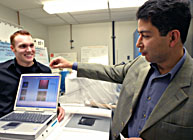Fingerprinting the bacterial bogeyman
Fingerprinting the bacterial bogeyman McGill University
User Tools (skip):
Fingerprinting the bacterial bogeyman
Research scientists at McGill are fingerprinting bacteria using infrared technology to cut identification time from days to hours. The project is being developed by McGill's infrared group in the Food Science department.

Jonah Kirkwood and Ashraf Ismail
Owen Egan
"The most important aspect of the project is that food will be safe," says Jonah Kirkwood, who's working on the project as part of his thesis for his master's in Food Science.
At present, Health Canada receives samples of every food lot that comes into the country, but can only test for one bacteria at a time.
"If somebody takes anthrax and puts it on broccoli, there is no way of checking for that," says Kirkwood. "Routine analysis for one foodborne pathogen takes two to four days. With this technology you can test for all the bacteria in the database in six hours."
Using the Focal Point Array Fourier Tranform Infrared Spectro-meter (FTIR), light is sent through a bacteria sample creating the spectrum of the bacteria. The technique is similar to crime scene analysis.
"An infrared spectrum is as unique to an organism or a molecule as a fingerprint is to a human," says Ashraf Ismail, a professor in McGill's Food Science Department and the supervisor of the project.
Infrared spectrometry is so versatile that in the future the database could be used to verify air quality as well as water and food quality.
To date, the project has generated half a million spectra of over 120 bacteria. The small size of the sample needed speeds up processing time. "We can now do in three days what it took a former doctorate student five years." Cutting processing time is key in bacterial identification.
"The time element is critical in a hospital setting, especially when identifying antibiotic resistant bacteria."
The technology is so user-friendly there is no need for a trained technician. "You just click a button and it's analyzed," says Kirkwood.
At this stage, the group is generating the database, the size of which is limited by the computer's ability to handle the information. The larger the bacterial database, the more likely the right answer is achieved.
"We're not taking an exact measurement, like a scale, so it's a little complicated," says Andrew Ghetler, the Food Science master's student responsible for developing the software to process the spectra. "My job is to make it so the size of the database doesn't effect the processing time."
Time with the FTIR hasn't been easy to come by. Both units are owned by Digilab, a company headquartered in Randolph, Massachusetts. The McGill infrared group has only had the FTIR for a total of four months this year.
After winning the Best Poster Award at the 2003 Health Canada Research Forum, the project caught the interest of Canadian Health Minister Anne McLellan. Upon learning that the FTIR belonged to Digilab, not Health Canada or McGill, McLellan said, "We'll have to see what we can do about that."
"Very few scientists at Health Canada meet the Minister," says Kirkwood. "I was thrilled to get the chance to speak with her."
At the project's current rate it could be completed in three to five years. "If Health Canada buys us an FTIR it could go a lot faster," says Ghetler.
Once the project is complete, the next step is implementing the technology.
"Maybe ten years from now it can be hand-held," says Ismail.
